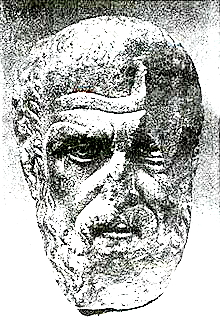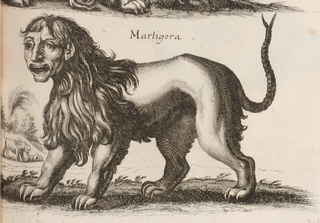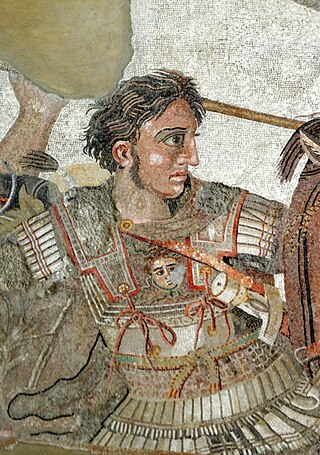Indica is classical Greek and Latin for "of India".
Indica is classical Greek and Latin for "of India".
Year 162 (CLXII) was a common year starting on Thursday of the Julian calendar. In the Roman Empire, it was known as the Year of the Consulship of Rusticusand Plautius.
Ctesias, also known as Ctesias of Cnidus, was a Greek physician and historian from the town of Cnidus in Caria, then part of the Achaemenid Empire.

Arrian of Nicomedia was a Greek historian, public servant, military commander, and philosopher of the Roman period.

Nearchus or Nearchos was one of the Greek officers, a navarch, in the army of Alexander the Great. He is known for his celebrated expeditionary voyage starting from the Indus River, through the Persian Gulf and ending at the mouth of the Tigris River following the Indian campaign of Alexander the Great, in 326–324 BC.
Megasthenes was an ancient Greek historian, diplomat, ethnographer and explorer in the Hellenistic period. He described India in his book Indica, which is now lost, but has been partially reconstructed from literary fragments found in later authors that quoted his work. Megasthenes was the first person from the Western world to leave a written description of India.

The manticore or mantichore is a Persian legendary creature similar to the Egyptian sphinx that proliferated in western European medieval art as well. It has the head of a human, the body of a lion and the tail of a scorpion or a tail of venomous spines similar to porcupine quills. There are some accounts that the spines can be launched like arrows. It eats its victims whole, using its three rows of teeth, and leaves no bones behind.
Hanno the Navigator was a Carthaginian explorer of the fifth century BC, best known for his naval exploration of the western coast of Africa. The only source of his voyage is a periplus translated into Greek. He has sometimes been identified as a king.

The plum-headed parakeet is a species of parakeet in the family Psittacidae. It is endemic to the Indian Subcontinent and was once thought to be conspecific with the blossom-headed parakeet before being elevated to a full species. Plum-headed parakeets are found in flocks, the males having a pinkish purple head and the females, a grey head. They fly swiftly with twists and turns accompanied by their distinctive calls.

The characteristic of cynocephaly, or cynocephalus, having the head of a canid, typically that of a dog or jackal, is a widely attested mythical phenomenon existing in many different forms and contexts. The literal meaning of cynocephaly is "dog-headedness"; however, that this refers to a human body with a dog head is implied. Such cynocephalics are known in mythology and legend from many parts of the world, including ancient Egypt, India, Greece, and China. Further mentions come from the medieval East and Europe. In modern popular culture cynocephalics are also encountered as characters in books, comics, and graphic novels. Cynocephaly is generally distinguished from lycanthropy (werewolfism) and dogs that can talk.
Anabasis is an expedition from a coastline into the interior of a country. Anabase and Anabasis may also refer to:

The Anabasis of Alexander was composed by Arrian of Nicomedia in the second century AD, most probably during the reign of Hadrian. The Anabasis is a history of the campaigns of Alexander the Great, specifically his conquest of the Persian Empire between 336 and 323 BC. Both the unusual title "Anabasis" and the work's seven-book structure reflect Arrian's emulation of the Greek historian Xenophon, whose own Anabasis in seven books concerned the earlier campaign "up-country" of Cyrus the Younger in 401 BC.
A metropolis is a large city.

Sibyrtius was a Greek officer from Crete in the service of Alexander the Great, who was the satrap of Arachosia and Gedrosia shortly after the death of Alexander until about 303 BC.

Indica is the name of a short military history about interior Asia, particularly the Indian subcontinent, written by Arrian in the 2nd century CE. The subject of the book is the expedition of Alexander the Great that occurred between 336 and 323 BCE, about 450 years before Arrian. The book mainly tells the story of Alexander's officer Nearchus' voyage from India to the Persian Gulf after Alexander the Great's conquest of the Indus Valley. However, much of the importance of the work comes from Arrian's in-depth asides describing the history, geography, and culture of the Ancient India. Arrian wrote his Indica in the Ionic dialect, taking Herodotus for his literary mode.

Pataliputra, adjacent to modern-day Patna, was a city in ancient India, originally built by Magadha ruler Ajatashatru in 490 BCE, as a small fort near the Ganges river. Udayin laid the foundation of the city of Pataliputra at the confluence of two rivers, the Son and the Ganges. He shifted his capital from Rajgriha to Pataliputra due to the latter's central location in the empire.

Indika is an account of Mauryan India by the Greek writer Megasthenes. The original work is now lost, but its fragments have survived in later Greek and Latin works. The earliest of these works are those by Diodorus Siculus, Strabo (Geographica), Pliny, and Arrian (Indica).
Iambulus or Jambulus was an ancient Greek merchant and the likely author of a utopian novel about the strange forms and figures of the inhabitants of the "Islands of the Sun". His name seems not to be Greek and reveals a Semitic or an Arabic origin.
There are numerous surviving ancient Greek and Latin sources on Alexander the Great, king of Macedon, as well as some Asian texts. The five main surviving accounts are by Arrian, Plutarch, Diodorus Siculus, Quintus Curtius Rufus, and Justin. In addition to these five main sources, there is the Metz Epitome, an anonymous late Latin work that narrates Alexander's campaigns from Hyrcania to India. Much is also recounted incidentally by other authors, including Strabo, Athenaeus, Polyaenus, Aelian, and others. Strabo, who gives a summary of Callisthenes, is an important source for Alexander's journey to Siwah.
Indica is a book by the classical Greek physician Ctesias purporting to describe the Indian subcontinent. Written in the fifth century BC, it is the first known Greek reference to that distant land. Ctesias was the court physician to king Artaxerxes II of Persia, and the book is not based on his own experiences, but on stories brought to Persia by traders, along the Silk Road from Serica, a land north of China and India where domesticated silk originated.
Persica is a lost Ancient Greek text, divided in 23 books, on Assyrian, Median and Persian history written by Ctesias of Cnidus, a physician at the court of the Persian king Artaxerxes II. The work's style and value for the study of the Achaemenid history have been a subject of much controversy among modern scholars.